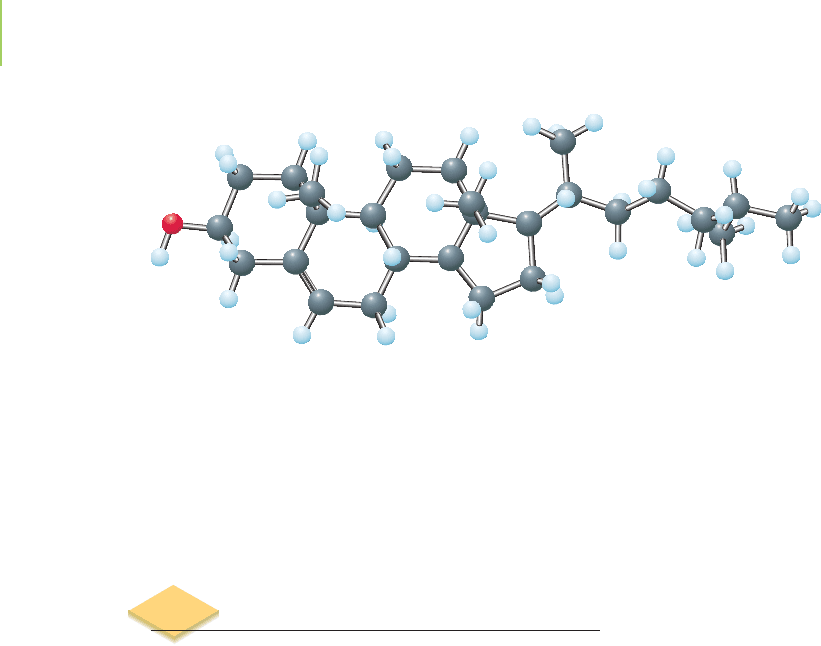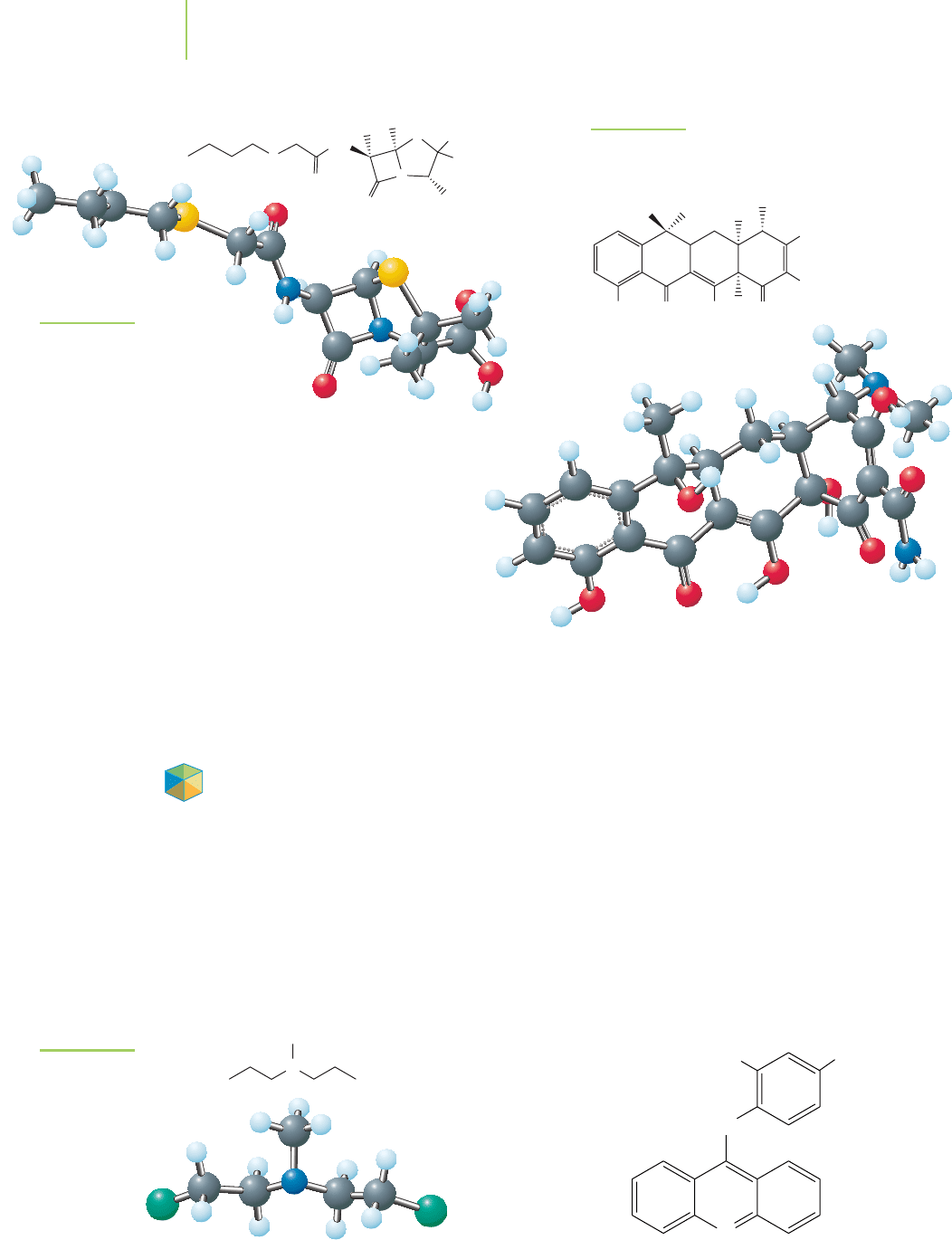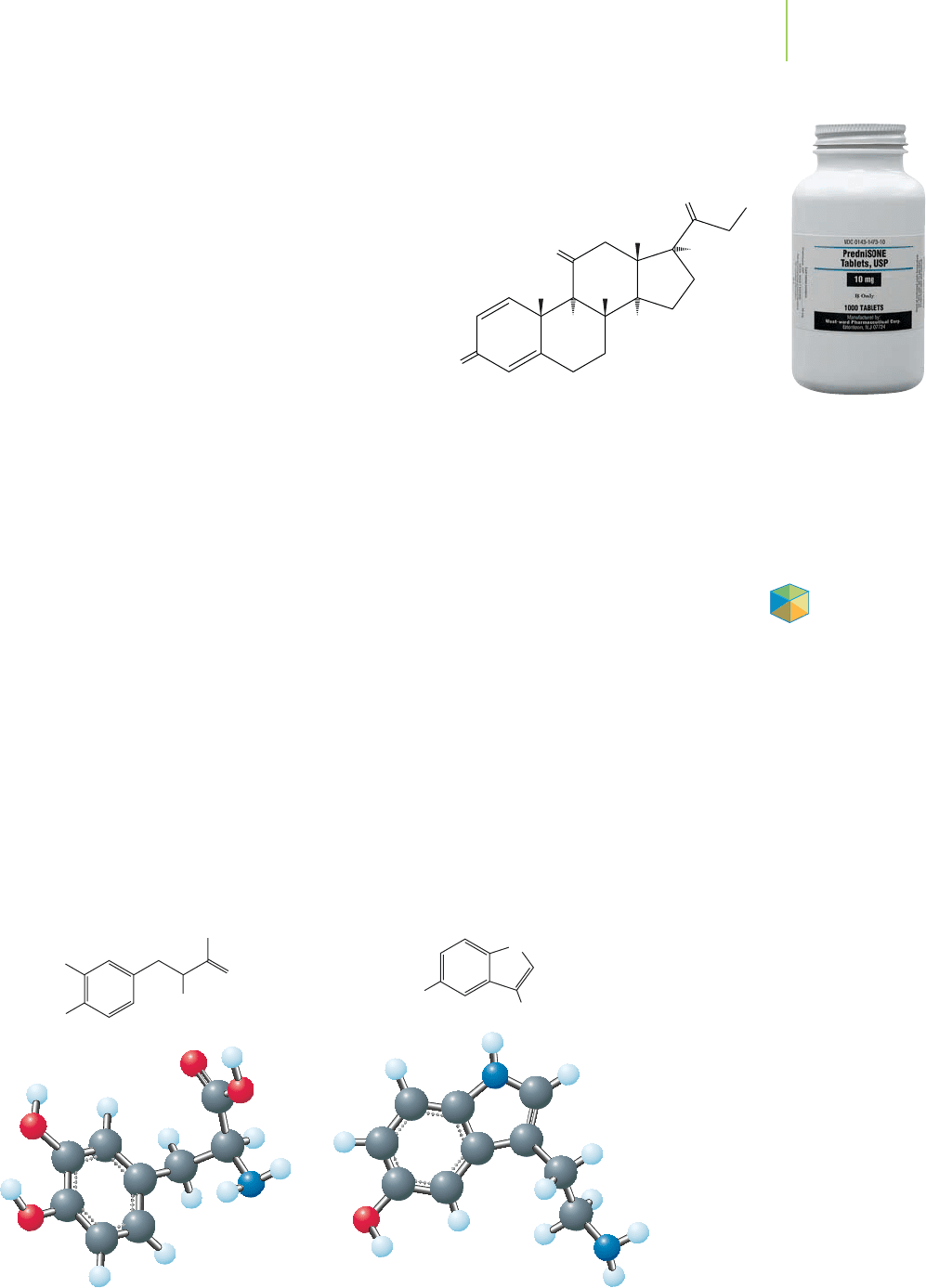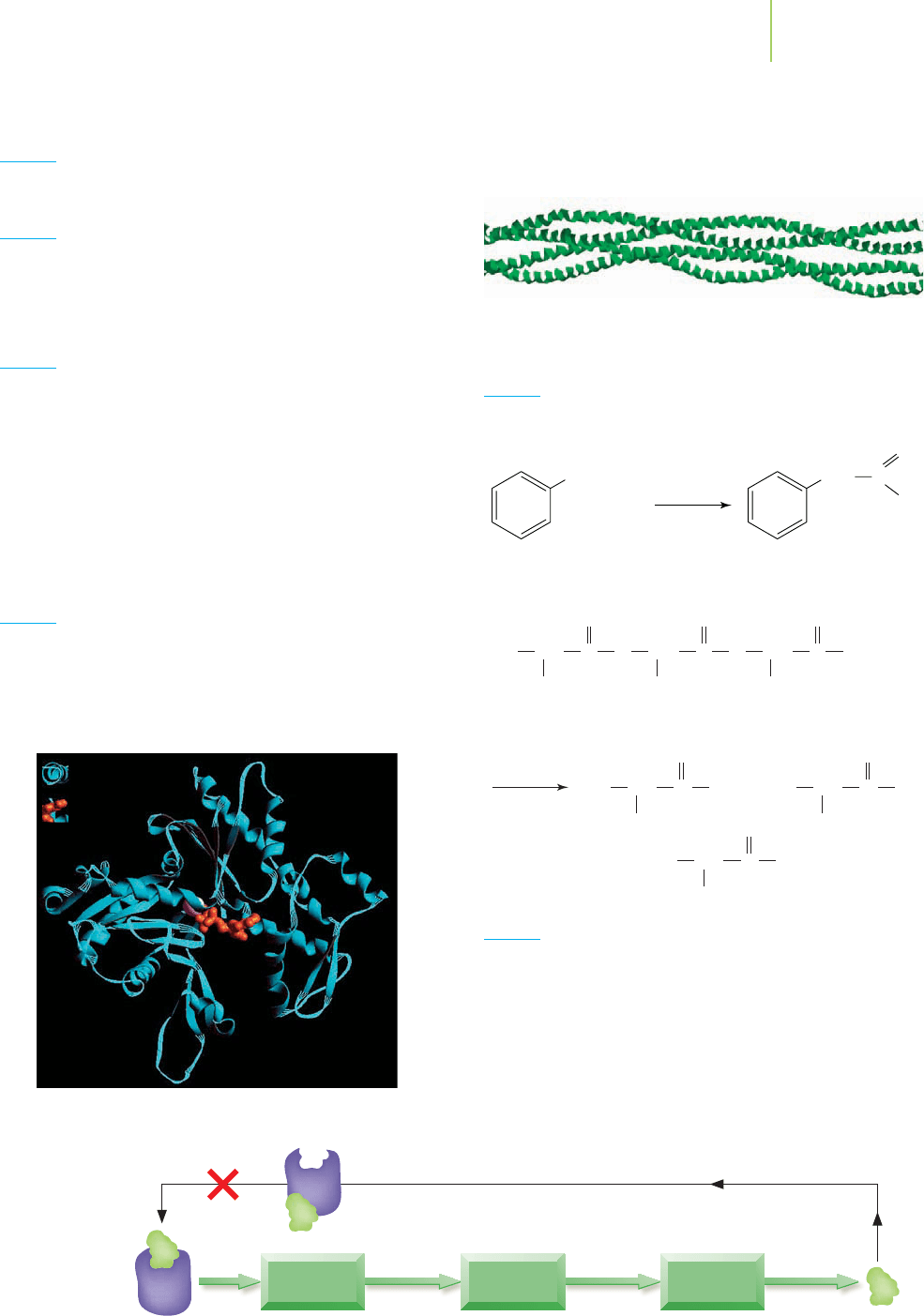Kelter P., Mosher M., Scott A. Chemistry. The Practical Science
Подождите немного. Документ загружается.


steroid hormones such as estrogen. Cholesterol has a bad reputation because of the
link between excessive blood cholesterol levels and cardiovascular disease, but it
is an essential component of cell membranes. Like almost every chemical associ-
ated with life, cholesterol is “good” in the right amounts and right places but
“bad” in the wrong amounts and wrong places.
22.8 The Maelstrom of Metabolism
Chemists have a rather simple chart to look at on their walls; we call it the peri-
odic table. Biochemists have a much more complex chart to admire. The bio-
chemical pathways chart shown in Figure 22.30 is so complex that, even devoting
a full book page to it, we struggle to make out the details. The most commonly
used version is more than 1 square meter in size, and even at that scale it still looks
dense and complex. The biochemical pathways chart summarizes the major se-
quences of chemical reactions of life, each particular sequence being called a
biochemical pathway. The individual pathways are interconnected at various
points, offering yet another example of glorious complexity. The chemical reac-
tions enable the atoms needed for life to flow through all the different molecules
and ions found in living things. The entire network of chemical reactions
involved in life is called
metabolism, and the individual chemicals are called
metabolites.
Each arrow on the biochemical pathways chart represents a chemical reaction
catalyzed by a specific enzyme. Looking at the chart, we can really begin to ap-
preciate the true complexity of life, the reasons why we need around 20,000 to
30,000 genes (always remembering that many genes code for proteins other than
enzymes), and the breathtaking achievement of the chemistry within each living
thing. We can also appreciate the other breathtaking achievement: that in a little
over 50 years, scientists have been able to sort this all out!
Breaking Things Down
and Building Them Up Again
The food we eat is a mixture of water, carbohydrate, protein, lipids, vitamins, and
minerals. It provides us with chemical raw materials needed to build the chemi-
cals of our bodies, and it also acts a source of energy. To release the energy, and
also to use much of our food as raw materials, our bodies must break the chemi-
cals in the food down into simpler forms. This aspect of metabolism is called
catabolism. Building the raw materials back up into our own carbohydrates, pro-
teins, lipids, and other essential chemicals is the aspect of metabolism called
anabolism.
958 Chapter 22 The Chemistry of Life
Cholesterol

22.8 The Maelstrom of Metabolism 959
FIGURE 22.30
The biochemical pathways chart.
Biochemical Pathways

Thalidomide bottle from 1961.
FIGURE 22.32
Thalidomide is a chiral molecule.
O
O
O
O
N
NH
O
22.9 Biochemistry and Chirality
There is a crucial aspect of the chemistry of life that we have not even mentioned
yet, and it is also an important aspect of the structure of many chemicals not nec-
essarily involved in living systems. Many of the molecules in our bodies are chiral,
a term we introduced in Chapter 12 (Section 12.14). For instance, the mirror
image forms of the general structure of an amino acid are shown in Figure 22.31.
These forms will be nonsuperimposable, provided that the R group is not a hy-
drogen atom. All amino acids except glycine are chiral, and the nonsuperimpos-
able forms of molecules such as this are known as
enantiomers.
Chirality is found in the body in a wide range of molecules, including amino
acids, proteins, carbohydrates, and even DNA and RNA. The amino acids in pro-
teins have, almost exclusively, the same handedness. That is, our bodies have
evolved to utilize only one of the two enantiomers possible in the amino acids.
The same is true for most of the carbohydrates in living things.
The carbohydrates of life are similarly almost exclusive in their
same handedness. Why is this so? This is another of the won-
derful mysteries of life.
Why is chirality in chemicals important? Because it controls
the way in which molecules interact. For example, the binding
sites of enzymes are constructed from the chiral amino acids
within protein molecules. Therefore, enzymes themselves are chi-
ral. They will interact differently with the different enantiomers
of the substrates to which they bind. In many cases, one enan-
tiomer of the substrate will be able to bind to the protein,
whereas the other will not fit into the active site. These distinc-
tions can be highly significant.
From 1958 to 1962, large numbers of pregnant women in
many countries began to take a drug called thalidomide, shown
in Figure 22.32. This drug was prescribed in an effort to control
the “morning sickness” that often accompanies the early stages
of pregnancy. The large batches of thalidomide prepared on an
industrial scale for distribution around the world contained
both enantiomers. One of these was very effective in controlling
morning sickness. Unfortunately, the other enantiomer caused a range of pro-
found abnormalities in the developing fetus. Babies born to mothers who had
taken thalidomide were badly deformed. These dangers became evident before
thalidomide received approval for use in the United States, which was therefore
fortunate enough never to experience the tragic wave of “thalidomide babies”
that occurred in other countries.
960 Chapter 22 The Chemistry of Life
The two isomers of glucose (D-glucose
and
L-glucose). D-Glucose is the enan-
tiomer that our bodies use for fuel.
COOH
R
H
2
N
C
H
COOH
R
NH
2
C
H
HHO
H
HO
CH
2
OH
H
OH
H
HO
CHO
OHH
HO
H
CH
2
OH
OH
H
OH
H
CHO
D-Glucose
HO OH
H
O
OH
HOH
OH
H
HH
L-Glucose
HO OH
OH
O
H
H
HO
HO
H
H
H
Application
FIGURE 22.31
Mirror images of an amino acid.

22.10 A Look to the Future 961
Thalidomide has since been found to be useful in treating some aspects of
various diseases, including leprosy, rheumatoid arthritis, AIDS, and some can-
cers, especially those related to blood marrow. It remains in use in carefully con-
trolled circumstances, but never for the treatment of women who are, or ever may
become, pregnant. Recently, a compound with a structure that is very similar to
that of thalidomide has been identified as a potential treatment for myelodys-
plastic syndrome, a malignant disorder that affects blood cell production. The
company manufacturing the drug is seeking approval from the U.S. Food and
Drug Administration to market the compound under the name Revlimid. Initial
studies have indicated that Revlimid has fewer of the harmful side effects caused
by thalidomide, and its use could be beneficial to patients afflicted with the ma-
lignant blood disorder.
Many scientists were perplexed at why the safe enantiomer of thalidomide
was not prepared and used in its pure form. Preparations of the safe enantiomer
can indeed be made, but over time, the pure enantiomers spontaneously convert
into a mixture of the two enantiomers, until an interconverting 50/50 mixture of
both forms, known as a
racemic mixture, is obtained. Unfortunately, the process
of
racemization occurs with many chiral molecules.
22.10 A Look to the Future
Talking about thalidomide reminds us that one major reason behind our interest
in the chemistry of life is the desire to prevent and treat the diseases and discom-
forts that can afflict us. Why do we get ill and what can chemistry do about it? The
major causes of illness and disease are
■
Infection—occurs when our bodies become home to harmful microorganisms
■
Abnormal growth of tissues—such as cancerous tumors and less damaging
“benign” tumors
■
Abnormal production of important biochemicals—such as hormones and the
neurotransmitters that make it possible for signals to pass between nerves
■
Genetic diseases—associated with one or more abnormal genes or larger ab-
normalities in genetic material
■
Aging—the degeneration of maintenance and repair functions within the
body
Every doctor’s shelf carries a large volume called a pharmacopeia (see Sec-
tion 18.1), a book that lists the drugs available to fight all manner of diseases and
includes instructions on dosage, uses, and possible adverse reactions. However,
many of these drugs have limited use, exhibit lessening effectiveness, or are sim-
ply ineffective at treating or curing diseases and maladies that affect humans. The
future of useful therapeutic agents relies on the preparation and implementation
of alternatives to these exisiting drugs. Some of the important current advances
in this area are noted here.
Antibiotics
Most of us are treated with antibiotics several times in our lives. These are chem-
icals that can inhibit the growth of microorganisms or even destroy them. The
first antibiotic that was isolated and used on patients was penicillin (Fig-
ure 22.33). This compound inhibits the synthesis of bacterial cell walls by selec-
tively binding to enzymes needed for such synthesis. Nowadays we have a vast
armory of antibiotics that work in different ways, but very often by binding to
and inhibiting specific enzymes. For example, the tetracycline antibiotics are all
Application

Cl Cl
N
Mechlorethamine
(also known as nitrogen mustard)
CH
3
962 Chapter 22 The Chemistry of Life
FIGURE 22.34
Tetracycline is an antibiotic useful for
treating many human infections.
H
HO
OH
OH HOOO
OH
CH
3
N(CH
3
)
2
CONH
2
S
N
S
H
NH
H
O
O
CH
3
CH
3
COOH
FIGURE 22.33
Penicillin was first identified on
moldy slices of bread.
derived from the basic structure of tetracycline (Figure 22.34). They work by
binding to and inhibiting enzymes that catalyze protein synthesis in bacteria.
Anticancer Agents
One major strategy for treating cancer is to prevent the replication of DNA
within cancerous cells. If DNA replication is prevented, the cells cannot multiply
by cell division. Various drugs have been developed that achieve this effect by
forming crosslinks between the two strands of DNA or by adding bulky groups to
one strand, thus preventing the double helix from unwinding in the manner re-
quired for replication. One of the oldest anticancer drugs is mechlorethamine,
shown in Figure 22.35, which forms crosslinks between the DNA strands. A more
recent anticancer agent called m-amsacrine inserts into the DNA helix and causes
the cell’s natural maintenance enzymes to break the DNA strand into little pieces.
m-Amsacrine is very effective in treating some forms of childhood leukemia.
NHSO
2
CH
3
HN
N
m-Amsacrine
(m-AMSA)
CH
3
O
FIGURE 22.35
Application

H
O
CH
3
H
OH
H
CH
3
OH
O
O
Hormones and Their Mimics
Insulin, injected under the skin, can be used to treat diabetic patients. Many other
nonprotein hormones are also used to treat disease. One major category of such
hormones consists of the steroid hormones, such as estrogen and testosterone.
Natural and synthetic steroids are used to treat
such conditions as cancer, rheumatoid arthritis,
allergies, and a wide range of hormone-deficiency
diseases. Synthetic steroids are also the active ingre-
dients in contraceptive pills and in the hormone re-
placement therapy sometimes used to combat the
effects of menopause in women.
Neurotransmitters
The nervous system is composed of billions of nerve cells that communicate with
one another via the release of small organic compounds known as neurotrans-
mitters. These chemicals bind to specific receptors on the surface of neighboring
nerve cells and either activate or inhibit the transmission of nerve impulses.
Many degenerative and psychiatric conditions are associated with abnormalities
in neurotransmitter function. The pronounced tremors of Parkinson’s disease,
for example, are due to the degeneration of nerve cells that use a molecule known
as dopamine as their neurotransmitter. The condition can be dramatically allevi-
ated by administering a precursor of dopamine called
L-Dopa, which is converted
to dopamine by enzymes in the body.
One of the most significant neurotransmitters is serotonin (5-hydroxytrypta-
mine). A large new range of drugs that appeared in the 1990s are useful because
of their ability to modulate the effects of this neurotransmitter in various cells
and tissues.
Another set of significant neurotransmitters are the endorphins, a class of
short polypeptides. Long-distance runners know the calming effects of endor-
phins. They give rise to the (nonaddictive) “runner’s high” that relieves stress for
hours after a long run. Many of the endorphins have also been implicated in
other significant biological effects. For instance, substance P shows remarkable
activity in ocular wound repair.
22.10 A Look to the Future 963
Prednisone is a synthetic hormone simi-
lar to cortisone that is used to treat
Crohn’s disease and a wide variety of
other ailments. The basic structure of
this compound reveals that it is a
steroid.
HO
HO
OH
O
NH
2
L-Dopa
HO
Serotonin
CH
2
CH
2
NH
2
N
H
Application

Alpha-neo-endorphin
glu
gly
lys
lys
tyr
ala
asn
lys
ile
ile
ala
asn
lys
phe
leu
thr
val
leu
pro
thr
gln
ser
lys
glu
ser
thr
met
phe
gly
gly
tyr
NH
2
NH
2
NH
2
lys
pro
tyr
lys
arg
leu
phe
gly
gly
tyr
pro
tyr
lys
arg
leu
phe
gly
gly
tyr
NH
2
Beta-neo-endorphin
Human-beta-endorphin
arg
pro
lys
pro
gln
gln
phe
phe
gly
leu
met
Substance P
Genetic Disease
Genetic diseases are those that are clearly associated with one or more abnormal
genes or larger abnormalities in genetic material. Genetic abnormalities give rise
to sickle-cell anemia, retinitis pigmentosa, obesity, and a host of other diseases.
How does damage in the gene cause disease? For each defective gene, there will be
a correspondingly defective protein where at least one amino acid has been re-
placed with an incorrect amino acid. Unfortunately, it is also possible to have ab-
normalities in the
chromosomes in which all of our DNA is packaged. Humans
contain 23 pairs of chromosomes, one copy of each pair inherited from each par-
ent. Having damaged, extra, or missing chromosomes can cause serious diseases.
One of the main driving forces behind the Human Genome Project that we
mentioned at the beginning of this chapter is the desire to identify all the genes
that are involved in genetic diseases. In doing so, scientists can learn exactly what
has gone wrong with them and, in many cases, discover how to compensate for
the defective proteins encoded by the genes. Eventually, we may even be able to
develop ways to repair the genes and restore their normal state. The idea of actu-
ally repairing genetic damage is known as
gene therapy. This advancement in sci-
ence is currently in the early stages of development and trials. Someday, in the not
too distant future, gene therapy may be performed on unborn babies to treat
their diseases before we welcome them into this oh, so interesting world.
964 Chapter 22 The Chemistry of Life
Application
The Bottom Line
■
DNA is a polymer of nucleotides made from two
complementary single strands wrapped around each
other to form a double helix. (Section 22.1)
■
Proteins are polymers of amino acids linked through
an amide bond (Section 22.2). They contain pri-
mary, secondary, tertiary, and sometimes quaternary
structure. (Sections 22.2, 22.3)
■
Proteins are made by translating the genetic code
from mRNA. tRNA supplies the specific amino acids
to the growing polypeptide chain. The construction
occurs at the ribosomes within the cytoplasm of a
cell. (Section 22.3)
■
Enzymes are proteins that contain an active site and
catalyze biochemical reactions. (Section 22.4)
■
Carbohydrates function as structural features such as
cell walls in plants and as energy storage molecules
in all living organisms. (Section 22.6)
■
Lipids are a diverse class of molecules with a variety
of functions. (Section 22.7)
■
Biological systems exploit the use of enantiomers.
Most amino acids and carbohydrates in living
organisms are only one of two possible enantiomers.
(Section 22.9)
■
The promising future activities in the chemistry of
medicines include development of new antibiotics,
new drugs to treat neurological disorders and cancer,
and gene therapy. (Section 22.10)
Endorphins include many
short-chain polypeptides.

active site The location on an enzyme where the re-
action of the substrate is catalyzed. (p. 948)
amide bond A bond constructed from the condensation
of an amine and a carboxylic acid. Represented by the
following general structure. (p. 940)
anabolism The metabolic process of constructing mole-
cules from smaller molecules using high-energy mol-
ecules that have been made by catabolism. (p. 958)
antibiotics Substances that kill, harm, or retard the
growth of microorganisms. (p. 961)
antibodies Large biological molecules that are produced
during an immune response, travel to the site of infec-
tion, bind to foreign material, and signal the destruc-
tion of the foreign material. (p. 954)
anticodon The three-nucleic-acid-sequence on a tRNA
polymer that recognizes and binds to the codon on
an mRNA polymer. (p. 943)
base pair A pair of nucleic acids that are intermolecu-
larly bound to each other through noncovalent forces
of attraction—for example, the combination of A
and T or of G and C in a DNA duplex. (p. 936)
biochemical pathway A sequence of biochemical reac-
tions that lead to the consumption or production of a
particular metabolite. (p. 958)
carbohydrates Compounds that have the general for-
mula C
x
(H
2
O)
y
. These compounds serve living or-
ganisms as structural molecules (cellulose), as cellular
recognition sites, and for energy storage (starch).
(p. 954)
catabolism The metabolic process of breaking down
molecules to form smaller molecules and produce
high-energy molecules. (p. 958)
chromosomes The packaged functional units of DNA.
(p. 964)
codon A three-nucleic-acid sequence on an mRNA that
is translated into a particular amino acid during pro-
tein synthesis. (p. 943)
collagen A structural protein that exhibits a linear
tertiary structure formed from intertwined alpha
helices. It is found in connective tissues in the body.
(p. 946)
denature To destroy the biochemical activity of a
protein. (p. 946)
deoxyribonucleic acid (DNA) A huge nucleotide polymer
that has a double-helical structure. Each strand of the
DNA polymer complements the other by forming
O
N
H
C
base pairs. DNA provides instructions for the synthe-
sis of proteins and enzymes that carry out the biolog-
ical activities of the cell. (p. 935)
deoxyribose A dehydrated carbohydrate used in the con-
struction of DNA. (p. 935)
disaccharide A carbohydrate made from the condensa-
tion of two simple sugars. (p. 956)
enantiomers A pair of molecules that are nonsuperim-
posable mirror images. (p. 960)
fat A triglyceride that is made from carboxylic acids
with long carbon chains and has a relatively high
melting point. Typcially derived from animal sources.
(p. 957)
fatty acids Carboxylic acids that contain long carbon
chains. Commonly serve as major building blocks for
the production of cell membranes. (p. 957)
gene A specific region of the DNA polymer that codes
(carries instructions) for a single protein. (p. 941)
gene therapy A relatively new area of biochemistry and
medicine wherein attempts are made to cure or treat
genetic diseases by modification of a patient’s dam-
aged genes. (p. 964)
hormones Small molecules, such as steroids, used by
living organisms for intercellular communication.
(p. 953)
lipids Biological compounds characterized by their
ability to dissolve in nonpolar solvents. They include
fatty acids, some vitamins, and the steroid hormones.
(p. 957)
messenger RNA (mRNA) A short-lived single strand of
ribonucleic acid that carries the information from a
gene to the ribosomes where a protein is constructed.
(p. 942)
metabolism The biochemical reactions inside living
cells. (p. 958)
metabolite A product of each step in a biochemical
pathway. (p. 958)
monosaccharide A small carbohydrate monomer. Typi-
cally contains between three and nine carbon atoms.
(p. 956)
nitrogenous organic base The portion of a nucleotide
where hydrogen bonding holds the strands of DNA
together in a duplex. (p. 935)
nucleotides Monomers of the nucleic acids. A nu-
cleotide contains a five-carbon sugar, a phosphate,
and a nitrogenous organic base. (p. 935)
oil A triglyceride made from carboxylic acids with long
carbon chains and a relatively low melting point.
Typically derived from plant sources. (p. 957)
phospholipid A phosphate-modified lipid. (p. 957)
polypeptide A polymer of amino acids linked by amide
bonds. (p. 941)
Key Words 965
Key Words

polysaccharide A polymer of carbohydrate monomers.
(p. 956)
primary structure The sequence of amino acids within a
protein. (p. 941)
protein A large polymer of amino acids. May contain
one or more polypeptides and often involves complex
and intricate folds of the chain. (p. 939)
quaternary structure The way in which two or more
polypeptide chains have folded to make a protein.
(p. 946)
racemic mixture A 1:1 mixture of two enantiomers.
(p. 961)
racemization The reaction that describes the prepara-
tion of a racemic mixture from a single enantiomer.
(p. 961)
regulation The control of the function of a gene or
enzyme. (p. 948)
replication The process by which DNA is duplicated
prior to cell division. (p. 938)
residue The portion of an amino acid that differs from
other amino acids. (p. 940)
ribonucleic acid (RNA) A nucleotide polymer that con-
tains the information from a single gene and either
transfers that information to the ribosomes (mRNA)
or recognizes and constructs the protein product
(tRNA). (p. 941)
ribosomes Large molecular structures within the cyto-
plasm of a cell that aid the construction of a protein
from mRNA, tRNA, and the amino acid building
blocks. (p. 944)
secondary structure The specific folds within a polypep-
tide chain. Common secondary structures include the
alpha helix and the beta pleated sheet. (p. 945)
steroids Molecules composed of three 6-member
carbon rings and one 5-member carbon ring fused
together. These compounds are part of the lipid
fraction of a cell and function as structural materials
and intercellular communicators. (p. 957)
substrate A reactant molecule that binds to an enzyme.
(p. 948)
sugars The simplest carbohydrates. (p. 955)
tertiary structure The way in which secondary structures
fold together within a polypeptide chain. (p. 946)
transcription The process by which mRNA is synthe-
sized from a gene. (p. 941)
transfer RNA (tRNA) A nucleic acid polymer that recog-
nizes the codon on mRNA and adds the correspond-
ing amino acid to the growing protein. (p. 943)
translation The process by which a protein is synthe-
sized from mRNA. (p. 941)
triglyceride (triacylglycerol) A molecule made from three
fatty acids and a molecule of glycerol. Functions as
structural material in cell membranes and as an
energy storage molecule. (p. 957)
vitamins Small molecules that we need for proper
health. Normally, vitamins either are not synthesized
in our bodies or are made in insufficient amounts.
(p. 950)
966 Chapter 22 The Chemistry of Life
Focus Your Learning
The answers to the odd-numbered problems and some selected
problems appear at the back of the book, as represented by the
blue numbering.
Section 22.1 DNA—The Basic Structure
Skill Review
1. Define the term DNA.
2. Define the term nucleic acid.
3. Indicate the complement for the following DNA sequence:
ATTAAAAAGGGACTA
4. Indicate the complement for the following DNA sequence:
GGCGAATTAGCCCA
Chemical Applications and Practices
5. A researcher has determined that a particular sequence in
double-stranded DNA can be cleaved by a laboratory
method. The method is specific for breaking DNA in the
middle of an ATTA sequence. How many breaks would occur
if the following single strand of DNA were paired with its
complement?
ATTAAAGCCTAATTACCATAAT
6. A short segment of DNA is prepared as a way to locate a
particular sequence in double-stranded DNA. To how many
locations would the following segment of DNA bind in the
double-stranded DNA shown?
Segment: ATGCA
DNA: TCGATTACGTATGCATTACGT
Section 22.2 Proteins
Skill Review
7. Cite two amino acids that differ by one carbon in their side
groups.
8. Cite two amino acids that have acidic side groups.
9. Show the two products that could result from the condensa-
tion of valine and phenylalanine. Identify the amide bonds in
each peptide.
10. Draw the three peptides that could be made from the con-
densation of two glycines and one proline. Identify the amide
bonds in each peptide.

Section 22.3 How Genes Code for Proteins
Skill Review
11. Define the term codon in your own words.
12. Describe the process of transforming the information in a
gene into a protein.
13. Explain how a mistake in the preparation of an mRNA could
result in a protein that contains the wrong amino acid.
14. Is it possible to have a mistake in a gene without a mistake in
the protein made by that gene? Explain.
Chemical Applications and Practices
15. A researcher isolates a fragment of a particular mRNA. Is this
fragment at the beginning, end, or somewhere in the middle
of the part that is translated into a protein?
UUUCGAAGUAUGGGUGGAGAUUCUCCCGCG
16. A particular genetic disorder causes an extra nucleotide to be
inserted into the mRNA of a gene. Assuming that the entire
mRNA is shown below and that the site of insertion is indi-
cated, what is the primary structure of a protein that would
result from the insertion of each of the four nucleotides?
g
AUG–AAU–UAU–CGG–AUU–UAA
17. The skeleton inside a cell is made up of microfilaments—
polymers of the protein known as actin. Judging on the basis
of the structure shown here, indicate whether actin is a glob-
ular or a fibrous protein?
Focus Your Learning
967
Actin
ATP
An actin protein holds a molecule of ATP.
Keratin
H
2
N
CH
3
CH C
H
N
O
H
N
H
CH
OH
O
C
H
CH
O
C
Enzyme
H
2
N
CH
3
CH C
O
OH
H
2
N
H
CH C
O
OH
H
2
N
H
CH C
O
OH
CH
2
CH
2
OH
Enzyme
O
H
CH
2
C
18. Keratin is a protein used in defining and holding the
structure of skin, hair, and claws. Judging on the basis of the
structure shown here, indicate whether keratin is a globular
or a fibrous protein?
Section 22.4 Enzymes
Skill Review
19. Identify the class of enzyme based on the following reaction:
20. Identify the class of enzyme based on the following reaction:
21. In some enzymatic reactions, the product is able to bind to
the active enzyme and inhibit its activity. Why would this be
a useful feature for an enzyme? Explain.
22. In some metabolic pathways (biochemical reactions involv-
ing multiple reactions), large concentrations of the final
product can turn off the activity of the first enzyme in the
pathway, as shown below. What advantage would this type of
regulation have over that described in Problem 21? Explain.
Enzyme 4
Product C
Enzyme 3
Product B
Enzyme 1
End product
Enzyme 2
Feedback inhibition
Product A
